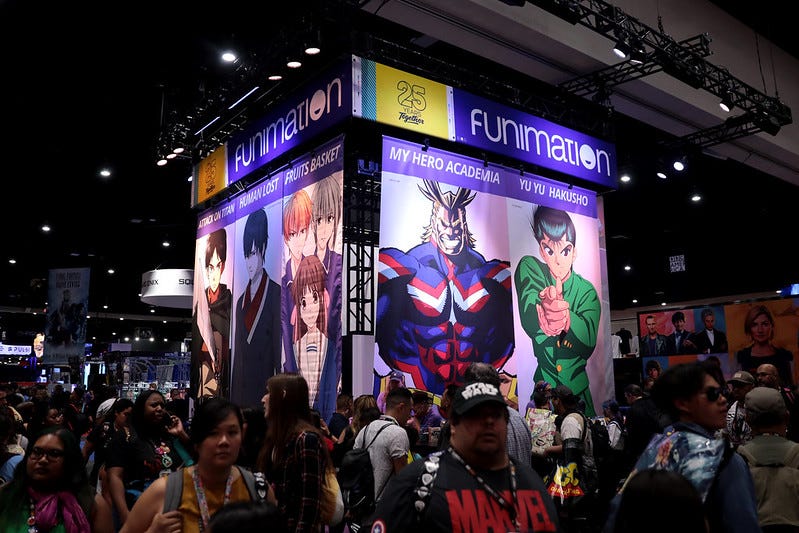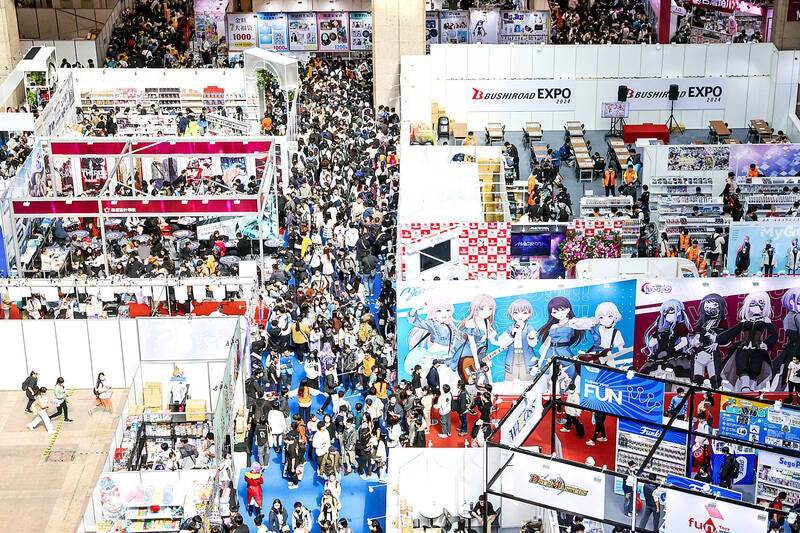Funimation sunsets, moves users to Crunchyroll
Plus: Anime studio turns to copyright assets for funding; First anime red carpet event in the Middle East; Taiwan's enthusiasm for anime and manga; and more
This is your weekly Animenomics briefing, covering the business of anime and manga. Today is Wednesday, February 14, 2024.
In case you missed it: Anime and manga artists are flocking to Bluesky after the social media platform opened to the public last week. Nagano, the artist behind popular comic strip Chiikawa, drew 100,000 followers within 24 hours of joining.
You can also follow Animenomics on Bluesky now.
Funimation ends service, consolidates into Crunchyroll

Funimation will close its anime streaming platform and merge with Crunchyroll, Sony announced last week. The entertainment giant acquired the two services in 2017 and 2021, respectively.
Why it matters: Consolidating the North American streaming services is the next step in Sony’s plan of building a global one-stop anime service on Crunchyroll.
Sony has been reporting subscriber numbers for both services under a single Crunchyroll brand since the 2021 fiscal year.
What’s happening: Funimation user accounts and subscriptions are migrating to Crunchyroll, and the former will end its streaming service on April 2.
Funimation’s premium plans that didn’t have their subscription prices raised in the first phase of the merger in 2022 will now see monthly and yearly costs increase to match Crunchyroll’s standard pricing.
Yes, but: Customers are upset that the migration won’t include digital copies sold with some of Funimation’s physical DVD and Blu-ray releases.
Funimation had told subscribers for years that digital content would be available “forever, but there are some restrictions”.
The about-face once again raises questions around ownership of and access to purchased media in the age of streaming, Ars Technica reports.
The Fandom Post editor-in-chief Chris Beveridge also found more than 180 titles in Funimation’s catalog that haven’t been migrated to Crunchyroll.
Our thought bubble: Funimation’s end of services is likely timed to coincide with last week’s release of the Crunchyroll app on Samsung smart television sets.
One in three smart televisions in the United States runs Samsung’s operating system, which only had the Funimation app until last week.
For anime studio Pierrot, copyrights are financial assets

Pierrot, the anime production studio known for titles like Naruto and Bleach, will allocate more financial resources to give back to animators and employees rather than creating bigger, more expensive anime episodes.
Why it matters: Pierrot’s approach, told by managing director Keiro Henmi to the web outlet Borderless, aims to change the perception that anime production work is “low profit and high sales”.
What they’re saying: “Anime isn’t made by computers, but by people,” Henmi says, emphasizing the need for fair treatment of and payment for labor.
“If those people become exhausted, there is nothing you can do about it,” he adds. “Such a way of making things will not last long.”
Under Henmi’s leadership, Pierrot has revised employee salaries and raised overtime pay retroactively by 20 percent.
Between the lines: Studios traditionally earn revenue from production fees paid by planning companies, but they are now looking for new ways to turn a profit in order to run a sustainable business.
Credit reporting agency Teikoku Databank found in an analysis last year that one in three anime studios is unprofitable.
How it works: Pierrot taps into the value of its intellectual property assets to gain the backing of banks, who put in money for the studio to invest in new works.
Henmi, who joined Pierrot in 2011 after working in banking for 25 years, pioneered the studio’s use of copyright as collateral for bank loans.
He was inspired to use this method to raise funds, called securitization, after seeing patent rights being used as loan collateral while working in New York.
Clippings: Saudis hold first anime red carpet event

Great Pretender Razbliuto’s premiere in Riyadh two weeks ago was the first anime red carpet event to be held in the Middle East. Local anime influencers and anime industry figures from Japan attended the event. (SubCulture Press)
Saudi content company Manga Productions secured the title’s Middle East and North Africa master license from Production I.G last year.
Tokyo Anime Award Festival’s Anime of the Year winners are Oshi no Ko in the television series category and The First Slam Dunk in the theatrical film category. (Tokyo Anime Award Festival)
Other winners for 2024 include Slam Dunk manga artist Takehiko Inoue, The Boy and the Heron animator Takeshi Honda, The First Slam Dunk CG director Taiki Nakazawa, and Oshi no Ko theme song performer YOASOBI.
Manga publisher Shogakukan is piloting a print-on-demand service that prints a single manga volume as soon as a customer order is received. The service will be made available for titles on the Manga One application. (Impress NetShop)
Japanese news media created a “spiral of anger” that escalated the Sexy Tanaka-san dispute and led to manga artist Hinako Ashihara’s death, business columnist Motohiko Tokuriki argues in an op-ed. (Yahoo! Japan News)
Sizing up the market for female anime and manga fans
“‘Kimi no Tonari ni Suwaru Hoshi.’ was developed as an IP that features male voice actors and astrology. It is the first project that targets the ¥1.8 trillion [US$12 billion] market of women who appreciate manga and anime.”
— Nippon TV Holdings earnings presentation for the fiscal period ending December 2023
Context: This paragraph in Nippon TV’s third quarter earnings presentation is believed to be first broad estimate of the size of the market for anime and manga works aimed at female audiences.
Rewind: As previously reported by Animenomics, the male idol anime genre is seeing a sales boom thanks to the enthusiasm of female fans.
Organizers of the Tokyo Anime Award Festival last week announced that the male idol anime concert film IDOLiSH7 LIVE 4bit BEYOND THE PERiOD had won the Anime Fan Award after a month of voting by the public.
Manga, anime enthusiasm goes on display in Taiwan

The 12th Taipei International Comics and Animation Festival, held over five days last week, generated NT$250 million (US$7.9 million) in revenue and drew about 480,000 attendees, according to organizers.
Why it matters: Taiwan has many local-language distributors of anime, manga, and light novels, which makes a sales-focused event like TiCA a good barometer of Taiwanese enthusiasm for Japanese media.
This year’s revenue is more than double last year’s revenue of NT$100 million (US$3.2 million).
On the ground: SubCulture Press reports that publishers like Ching Win, Taiwan Tohan, and Sharp Point Press set up large-scale booths resembling a bookstore sales floor.
Medialink, one of Asia’s largest distributors of anime content and merchandise, exhibited popular titles like Spy × Family and Oshi no Ko.
Anime studios actively participated by exhibiting their own works, something that isn’t usually seen in Japanese events.
Bottom line: As previously reported by Animenomics, Japanese companies signed more anime contracts in Taiwan than in any other territory in 2022, and Taiwanese distributors are now seeing the windfall of those transactions.
Animenomics is an independently-run and reader-supported publication. If you enjoyed this newsletter, consider sharing it with others.



Crunchyroll took over a anime site based in Europe few years ago.
Been told that everything that was avalible there would end up on Crunchyroll. None of them came there….. Just sucks, that things are still region blocked in 2024…